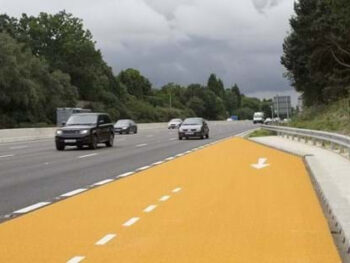Smart motorway ‘experiment’ has failed, say three in five drivers
Three in five drivers want smart motorways scrapped and converted back with a permanent hard shoulder.

The AA says half of the schemes to add extra emergency areas remain incomplete
The study, carried out by the AA, also found that a third of drivers feel a lot less safe on any form of smart motorway than they did three years ago and two-thirds felt safer on a traditional motorway.
The study shows the scale of anxiety drivers suffer on smart motorways. With National Highways’ fourth annual safety Stocktake overdue, the AA is calling for the report to be published urgently.
The motoring services firm’s survey of more than 13,500 drivers found that motorways where the hard shoulder can be switched on and off at peak times to create an additional running lane caused the highest number of respondents to say they didn’t feel safe.
Comments from respondents include, “I believe smart motorways are incredibly dangerous”, and “I do not think I would feel safe if I broke down on one”, while one driver said smart motorways are “anxiety inducing”.
The former Conservative government announced in 2023 there would be no further smart motorways built in England, but three-fifths of drivers also want the existing smart motorway network converted back to traditional three running lanes with a permanent hard shoulder. Just 11% said the network should be left in its current state; 9% said that all running lane systems should be converted to ‘dynamic hard shoulder’ schemes and 14% said that they should be turned into ‘controlled motorways’.
The AA has called again for existing smart motorways to be scrapped. At least 79 people have been killed on smart motorways between 2010 and 2024. Figures suggest if you break down on a smart motorway without a hard shoulder you are three times more likely to be killed or seriously injured than on one with a hard shoulder.
It’s also warned that half of the schemes to add extra emergency area remain incomplete. In 2020, the Tories pledged just under £1bn to improve safety on the network, including building 150 more emergency areas to cut the distance between these safe places to stop in an emergency from 1.5 miles to 0.75. Around half of these schemes have been completed with half still under construction, including on sections of the M1, M3, M4, M5, M20 and M25.
And Jack Cousens, head of roads policy for the AA, said there have been numerous reports of signal outages and CCTV failures across the network in recent years.
He added: “It is vital the overdue Stocktake is released so we can understand the impact of these technical failures.
“More emergency areas will help, but drivers are frustrated with the perceived lack of urgency to complete the work. While many upgrades have been completed, there are several major motorways that only began work last year.
“Both the AA and drivers say this experiment has failed and urge for the reinstatement of a permanent hard shoulder.”
A National Highways spokesperson said: “The safety data continues to show that, overall, in terms of deaths or serious injuries, smart motorways are our safest roads.
“It is important drivers feel safe and that’s why we have made further improvements including upgrading the technology to detect stopped vehicles and improving response times to live lane breakdowns. On top of this we have made good progress on the delivery of our commitment to install 150 new emergency areas, with all work due to be completed by next month.”
AA survey findings
Compared to three years ago, to what extent do you feel safe driving on each of the following types of motorways?
| A motorway with a continuous hard shoulder
|
A motorway with no hard shoulder but with emergency refuge areas (lay-bys) about one and a half (1.5) miles apart
|
A motorway with no hard shoulder but with emergency refuge areas (lay-bys) about three quarters (0.75) of a mile apart
|
A motorway where the hard shoulder can be ‘switched on and off’ so it can be used as a running lane at peak times
|
|
| A lot safer | 66% | 16% | 18% | 16% |
| A lot less safe | 2% | 30% | 27% | 34% |















